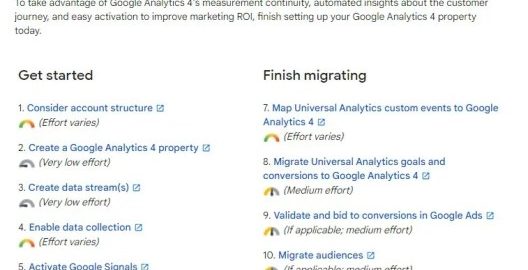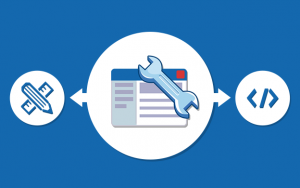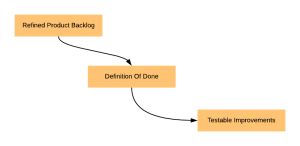GA4 will replace the current version of Google Analytics (Universal Analytics or UA) on July 1, 2023. It is essential…
GA4 will replace the current version of Google Analytics (Universal Analytics or UA) on July 1, 2023. It is essential that your data is migrated carefully to avoid any loss.

It’s no secret that great analytics is one of the keys to business success. Google Analytics has been instrumental in helping your company make wiser, more informed decisions, achieve various goals, better understand your customers and gain insight into your competitors. Google is taking analytics to a whole new level and moving to GA4, delivering even greater insights to propel your business forward. Keep reading to learn more about migrating to GA4, and why it’s important you get started now.
What is the difference between GA Universal and GA4?
Although Universal Analytics (UA) has been around for nine years, it was simply an upgrade of the original Google Analytics Classic. Universal Analytics uses a measurement model based on sessions and pageviews. Google defines a session as:
“A session is a group of user interactions with your website that take place within a given time frame. For example, a single session can contain multiple page views, events, social interactions, and ecommerce transactions.” … ”You can think of a session as the container for the actions a user takes on your site.”
While GA Universal is page-focused, GA4 is very different. Rather than focus on page views, GA4 uses a brand-new type of measurement based on events. It tracks individual page elements’ performance and relative contribution, complete with variations. GA4 makes it possible to measure the lived experience instead of a proxy, delivering a full picture of user behaviour and eliminating blind spots as you track a user through their entire journey through your website.
Whether your visitor is engaging with your business through a mobile app, software or your website, all traffic sources are now tracked in one place, without the need for additional products like App + Web. You’ll notice a lot of differences, including a new interface. GA4 also uses new Google Tags, and you will need a new Google Analytics property for storing data.
How we use the internet has changed; websites are dynamic, surfers use multiple devices in varying ways, and data collection laws have shown us that individual tracking and targeting will soon be a thing of the past. Add to these breakneck advances in marketing technology and profound shifts in consumer behaviour and attitudes. These changes suggest that the data you’re basing your decisions on can be enhanced or approved, and a new method of measuring user behaviour is needed to react to these changes.
Some of the highlights of GA4:
| Analysis | A new reporting section with the ability to do advanced analysis and create specific funnels based on any event you like. |
| Improved Data Model | GA4’s improved data model makes creating and analyzing reports more straightforward and intuitive while delivering more reliable data. |
| Predictive Metrics | Gaze into Google’s crystal ball and predict the future behaviour of your users. Purchase probability, churn probability and revenue probability are all supported by GA4. |
But it’s a year away; what’s the rush?
While Google recently announced a sunset date of June 2023 for GA Universal, migrating to GA4 sooner than later will only benefit your company. After all, by next year, you’ll be using it regardless. By making the switch now, you’ll have the opportunity to collect both sets of data for at least a year and have the ability to compare apples to apples when analyzing year-over-year data.
Machine learning is another important reason for getting on the GA4 train sooner than later. Machine learning helps to plug some of the gaps in your visitor data. The sooner you start collecting data; the more accurate the algorithm will be.
3 Important reasons to migrate to GA4 right now
When it comes right down to it, you really have no choice. By July 1, 2023, you’ll have to switch over to GA4. However, there are a few important reasons you should migrate now instead of delaying the inevitable.
- GA4 is forward-facing only – GA4 will not import your previous data; it will only collect data from the time of creation. The sooner you migrate, the more data you will have at your disposal, including year over year data.
- Enjoy the benefits of better data now – GA4 offers a variety of benefits and makes it easier to get the custom reports you’re looking for, enabling you to make informed decisions more quickly and increasing your website’s effectiveness.
- Consider it a soft launch period – GA4 is the future of analytics. Already fully functional, the system is poised to add new analysis technology without requiring additional code. Over time, Google will add even more standard features. Use this time to get comfortable with the changes and ensure everything is set up precisely the way you need it to be and goals are being tracked correctly.
Already the default property type when creating a new Google Analytics property, GA4 will soon be the standard for analytics. By setting up GA4 now and running it in parallel with legacy analytics, you’ll reap all the benefits of the new system sooner, have time to get comfortable with the new interface and be better prepared for what’s to come. Early implementation will help your business take advantage of the enhanced experience and data sooner rather than later. Why wait?
Of course, nothing is entirely risk-free. We have identified four potential risks of migrating to GA4:
- The analytics migration process can be complex and may influence your reporting and analysis in unexpected ways.
- GA4 Documentation is not yet thorough.
- Some features of UA are missing from GA4. Essentially, some of these shiny new features will come at the expense of some of our old favourites.
- Because these two methods of data collection differ, report data will not synch up perfectly after the transition.
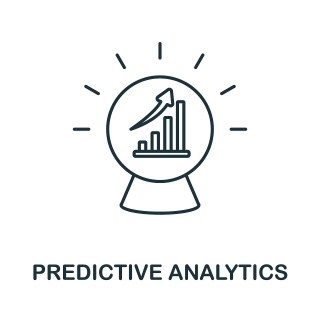
Taking the leap from descriptive to predictive analytics
Migrating to GA4 might not be as simple as it seems, and it is definitely not as easy as merely changing the old code to a new one. It’s easy for data to be missed in the transition, and your data must be carefully migrated to avoid any loss. Currently, some data does not exist in the same way you see it in GA Universal.
Our recommendation is to install GA4 and run it parallel with GA Universal. Running the two systems side-by-side over the next 13 months before you are forced to switch over will immediately start the clock on new data collection and insights while still having access to historical data.
Afterwards, sit back and let all that juicy data accumulate. Once you’re ready to start using GA4 as your primary analytics platform, you’ll have a year’s worth of historical data with which baselines can be established.
The importance of migrating to GA4 properly
Enlisting the services of GA specialists to migrate your analytics to GA4 can ensure valuable data is not lost. The changes in data collection between GA Universal and GA4 will require many changes to be implemented and tested before any replication of your current dataset can be done.
Because the reporting interface is also new, it will take time to become familiarized with it. A side-by-side migration can help you access the information in the way you are already comfortable while becoming familiar with the new system, making the adjustment easier.
Here are the steps Google recommends taking when migrating to GA4 and their associated level of effort/skill.
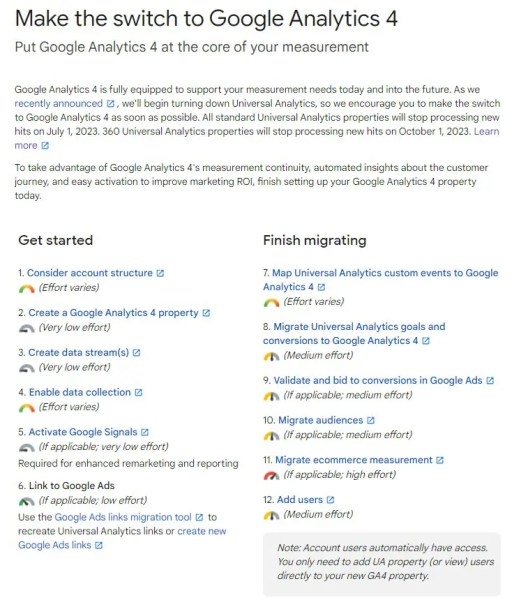
SEP has identified a few additional items to be addressed, which are not mentioned in Google’s checklist:
Because the Google Analytics “view” is changing in GA4, your traditional APIs will no longer work on your 3rd party platforms, CRMs, dashboards etc.
APIs will need to be adjusted, and your connections to dashboards and reporting tools will need to be reconfigured for the new property without a view.
New filters will need to be created and you will also need to plan how GA4 will fit into your business as a whole, including training and reporting.
What happens next?
- On July 1, 2023, all standard Universal Analytics properties will stop processing new hits.
- On October 1, 2023, all 360 Universal Analytics properties will stop processing new hits.
- Afterwards, previously processed data will only be accessible for six months.
Yep, you read that right. You will only have access to previously processed data for six months after UA’s sunset date. Fortunately, as an added level of protection, SEP has stored our client’s legacy data in-house; however, In-platform year after year data is crucial, which means that time is of the essence when migrating to ga4.
How SEP can help you migrate to GA4
SEP is ready to help with your migration needs, and we can look after your GA4 migration from strategic planning to actual implementation. If you’re ready to take the leap and go beyond a basic integration to maximize the benefits of GA4 sooner than later, we can surely help. Reach out to us to chat about your requirements.
The post Movin’ On Up! Why Migrating to Google Analytics 4 (GA4) Should be a Priority appeared first on Search Engine People Blog.
(14)
